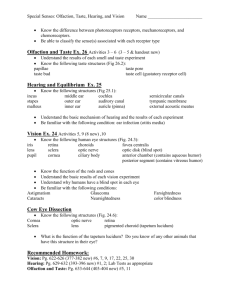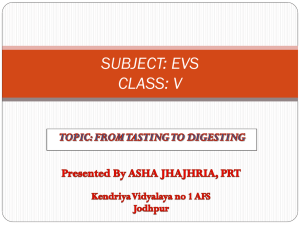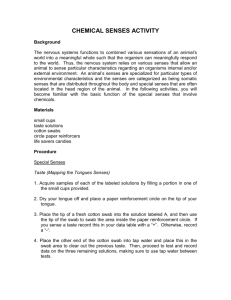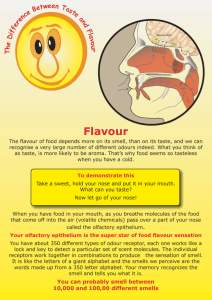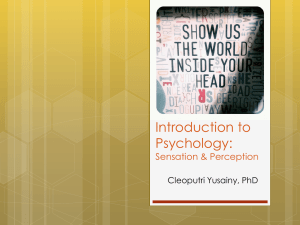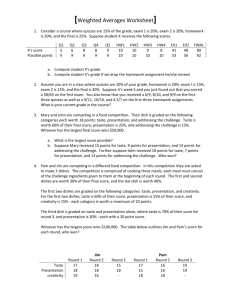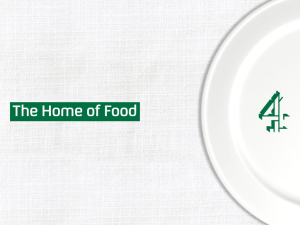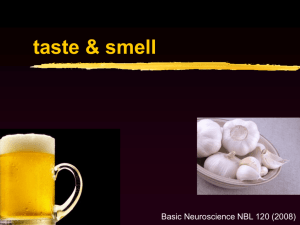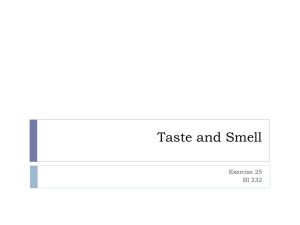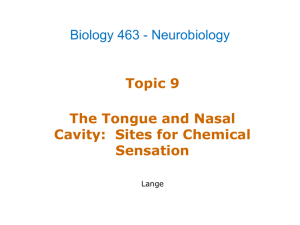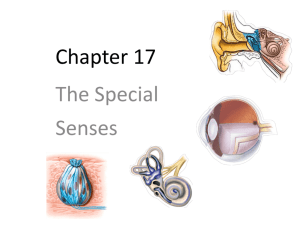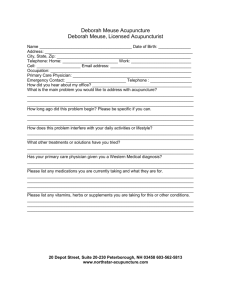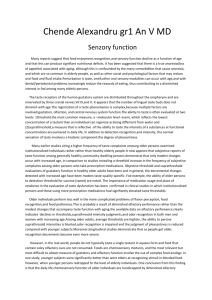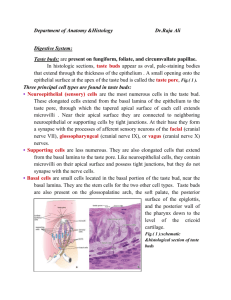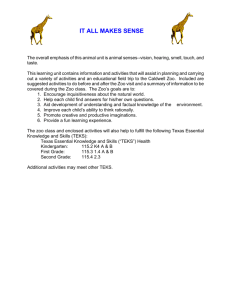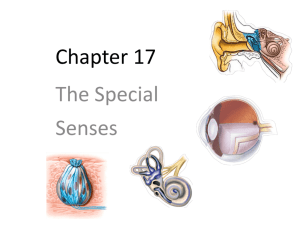Touch – The Skin Senses
advertisement
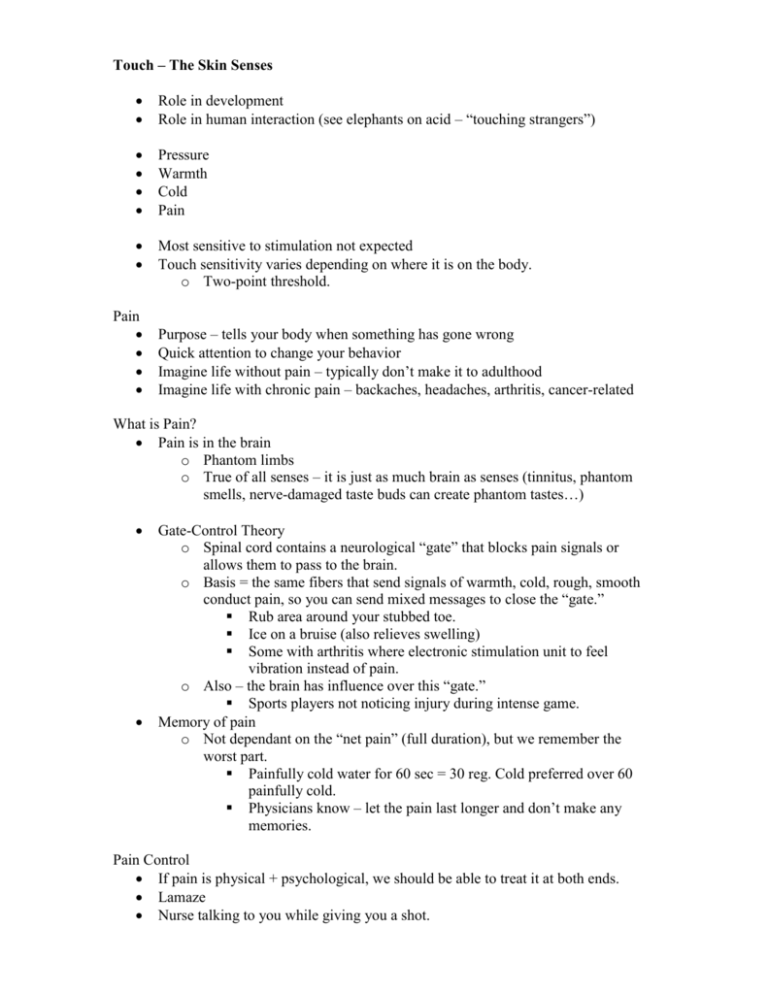
Touch – The Skin Senses Role in development Role in human interaction (see elephants on acid – “touching strangers”) Pressure Warmth Cold Pain Most sensitive to stimulation not expected Touch sensitivity varies depending on where it is on the body. o Two-point threshold. Pain Purpose – tells your body when something has gone wrong Quick attention to change your behavior Imagine life without pain – typically don’t make it to adulthood Imagine life with chronic pain – backaches, headaches, arthritis, cancer-related What is Pain? Pain is in the brain o Phantom limbs o True of all senses – it is just as much brain as senses (tinnitus, phantom smells, nerve-damaged taste buds can create phantom tastes…) Gate-Control Theory o Spinal cord contains a neurological “gate” that blocks pain signals or allows them to pass to the brain. o Basis = the same fibers that send signals of warmth, cold, rough, smooth conduct pain, so you can send mixed messages to close the “gate.” Rub area around your stubbed toe. Ice on a bruise (also relieves swelling) Some with arthritis where electronic stimulation unit to feel vibration instead of pain. o Also – the brain has influence over this “gate.” Sports players not noticing injury during intense game. Memory of pain o Not dependant on the “net pain” (full duration), but we remember the worst part. Painfully cold water for 60 sec = 30 reg. Cold preferred over 60 painfully cold. Physicians know – let the pain last longer and don’t make any memories. Pain Control If pain is physical + psychological, we should be able to treat it at both ends. Lamaze Nurse talking to you while giving you a shot. Taste (Gustation) Chemical sense (Chemoreception – gustation and olfaction) Sweet, sour, salty, bitter (savory - umami) o All other tastes are mixtures of these Tough to find specific nerve fibers for each, but we do recognize some regions o Show tongue overhead Each bump on top and sides has 200 taste buds (approx. 10,000 total) o Each taste bud contains a pore that collects taste chemicals o Each pore has approx. 50 taste receptor cells that are like antennae o Taste buds reproduce receptor cells (burning your tongue) Taste buds # and sensitivity decrease over time Supertasters (25%), tasters (50%), nontasters (25%) – determined by # papilla (fungiform, filliform) Ability to recognize taste with the tongue is to avoid poison. Smell and Taste Starburst experiment Eating when you have a cold o Demonstrated the importance of smell in “taste.” Anosmia (inability to smell) – inability to taste well Sensory Interaction Principle that one sense may influence another, mostly smell and taste. o Another example is seeing a person helps us correctly perceive a voice as directly in front of us. Smell (Olfaction) Chemical sense Only sense not processed through the thalamus 5 million receptor cells at the top of each nasal cavity o Olfactory receptor cells are like anemones in the reef. Detect approx. 10,000 odors through these receptors that work together. (Not one molecule for each odor.) Very primitive structure and process o Original purpose – sniff for food and predators o Animals use this for biological purposes – salmon to breeding ground, moths to mates, sharks to food, etc o Humans have other senses that are now far more accurate/helpful Strong at triggering memories o State-dependency (learn while smelling chocolate, better memory w choc) o Mood congruency (smelling something pleasant evokes good memories) Body Position and Movement Kinethesis – system for sensing the position and movement of individual body parts. Wake up in the middle of the night, how your body is positioned Every little twist or turn is sent to brain. Book discusses a man who loses this sense – he cannot walk or eat without the assistance of his sense of sight. Vestibular Sense – sense of body movement and position; including balance Semicircular canals (above cochlea) Vestibular sacs (connect canals with cochlea) o These contain fluid that moves when the head rotates or tilts o Send information to brain, allowing you to sense your (full) body position Spinning around – doesn’t go back to normal too fast, resulting in the perception that you are still spinning. Sensory Restriction (Deprivation) Bad: solitary confinement, participants in a 1957 study on sensory deprivation (hallucinations, depression, disoriented, and suggestible). o But what is causing this – could be stress of confinement Good: meditative state, no stimulation can help focus the mind





